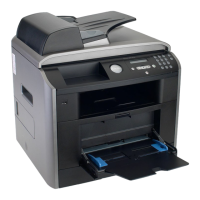
Do you have a question about the Dell 1815dn Multifunction Mono Laser Printer and is the answer not in the manual?
| Print Technology | Laser |
|---|---|
| Functions | Print, Copy, Scan, Fax |
| Print Resolution | Up to 1200 x 1200 dpi |
| Connectivity | USB 2.0, Ethernet |
| Paper Handling | 250-sheet input tray, 50-sheet multipurpose tray |
| Automatic Document Feeder | 50-sheet |
| Duplex Printing | Yes |
| Scanner Type | Flatbed, ADF |
| Fax Transmission Speed | 33.6 Kbps |
| Scan Resolution | 600 x 600 dpi |
| Media Size | Letter, Legal, Executive, A4, A5, B5, Envelopes |
| Media Type | Plain paper, Envelopes, Labels, Transparencies |
| Operating System Compatibility | Windows, Mac, Linux |
| Print Speed | Up to 27 ppm (Letter, Black) |
Proper placement and environmental conditions for printer setup.
Verifying all necessary items are included in the printer box.
Steps for safely removing the printer from its packaging.
Description of the printer's front components and layout.
Explanation of basic operator panel buttons and their functions.
Details on using the numeric keypad for input and commands.
Procedures for redistributing toner and opening the cover.
Instructions for loading paper into the printer's main tray.
Guide for connecting the printer to a telephone line for faxing.
Steps for connecting the printer directly to a computer using a USB cable.
Steps for connecting the printer to a network using an Ethernet cable.
Configuration for reducing power consumption when idle.
Power saving for the scanner lamp when not in use.
Steps to set a four-digit passcode for printer security.
Enabling the passcode protection feature for unauthorized access.
Instructions for loading paper specifically for copy jobs.
How to choose the paper source for copy output.
Guidelines for placing originals on the scanner or ADF.
Procedure for using the Automatic Document Feeder.
Procedure for placing documents on the document glass.
Instructions on how to load originals for the copy process.
Adjusting settings like copies, size, contrast, and quality.
Overview of advanced copying functions like ID Copy, Auto Fit.
Selecting the quantity of copies to be produced.
Adjusting the scale of copied images from 25% to 400%.
Modifying copy lightness or darkness.
Adjusting image quality based on document type.
Copying two-sided documents onto one sheet.
Automatically resizing originals to fit the paper.
Configuring the printer's identification for sending faxes.
Modifying default fax settings like contrast, resolution, and rings to answer.
Fine-tuning contrast for lighter or darker fax output.
Optimizing resolution for scan quality and fax output.
Understanding different modes for receiving faxes (Fax, Tel, Ans/Fax).
Paper requirements for printing received faxes.
Printer's default mode for automatic fax reception.
Procedure for manual fax reception using a telephone.
Storing frequently dialed numbers for quick access.
Step-by-step guide to saving speed dial entries.
Creating groups of fax numbers for multi-destination sending.
Browsing the phonebook alphabetically from A to Z.
Quickly finding entries by specifying the first letter.
Redialing the most recently dialed fax number.
Sending a document to multiple locations simultaneously.
Activating secure mode to prevent unauthorized fax printing.
Instructions for printing phonebook, sent/received fax, system data, and email reports.
Modifying advanced fax settings like Send/Receive Forward.
Steps to install the PC-Fax software for sending faxes.
Configuring name, number, and printer selection for PC-Fax.
Procedure for sending documents as faxes from a computer.
Information on installing drivers and accessing the user's guide.
Accessing online support, drivers, and documentation.
Overview, system, hardware requirements, and software for Linux.
Initial steps for installing the printer driver in a Linux environment.
Launching the configuration tool from the desktop or start menu.
Navigating through Printers and Classes tabs.
Managing printers, adding, removing, and setting defaults.
Managing printer classes for grouping devices.
Adjusting scan options like image quality and scan area.
Steps for loading documents and initiating a scan.
Steps to install printer software on Macintosh computers.
Configuring network or USB connections for Macintosh.
Enhancing text appearance and enabling toner saving.
Fine-tuning print appearance with advanced settings.
Applying predefined watermarks to documents.
Adding, editing, and deleting custom watermark text.
Creating custom overlays with logos or images and printing them.
Removing page overlays that are no longer needed.
Introduction to scanning features and the general steps involved.
Sending scanned images to specific software applications.
Overview of scanning documents over a network.
Adding and removing users for network scanning access.
Procedure for scanning documents to a network computer.
Configuring General, Server, Advanced, and Preferences pages.
Overview of USB memory key capabilities and connection.
Scanning documents using preset configurations to USB.
Deleting, formatting, printing from, and viewing status of USB key files.
Configuring printer settings for sending emails.
Scanning documents and sending them via email.
Adding and sending email addresses using the address book.
Modifying or removing email entries from the address book.
Assigning, deleting, and editing group email addresses.
Sending emails to multiple recipients using group dial numbers.
List of software included with the printer and their functions.
Monitoring printer status and changing settings via web browser.
General steps for installing software, including OS requirements.
Displaying printer status and toner levels on the computer.
Monitoring status of multiple printers on a network.
Managing phonebook, fax settings, and scan destinations.
Technical specifications for general printer functions and scanning.
Technical specifications for multi-function and facsimile capabilities.
Information on paper types, sizes, and support.
Best practices for using paper to avoid jams and ensure quality.
Procedures for clearing jams in ADF, paper paths, fuser, and duplex.
Interpreting LCD error messages and general troubleshooting steps.
Troubleshooting paper feed errors, slow printing, and blank pages.
Addressing issues like faded print, toner specks, and vertical lines.
Resolving toner smear, character, skew, curl, and dirty printout problems.
Troubleshooting black pages, loose toner, voids, stripes, and curl fax problems.
Resolving issues with printing, fax reception, and sending.
Troubleshooting scanner errors and network scan issues.
Resolving issues when printing or scanning from Macintosh.
Troubleshooting PostScript file printing and related errors.
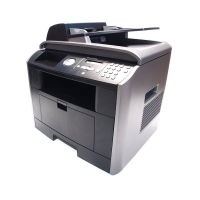
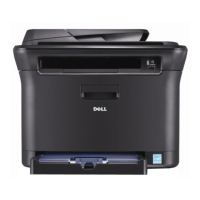
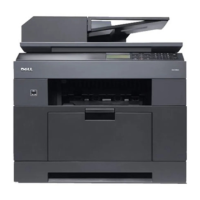

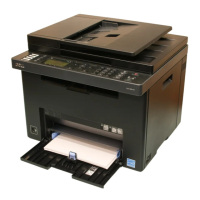
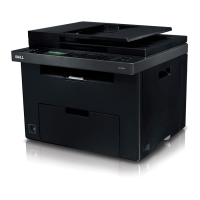
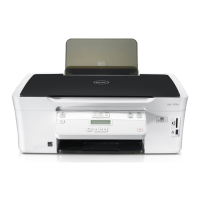

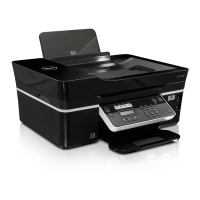
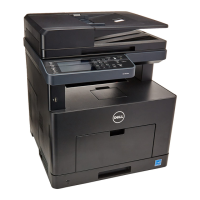

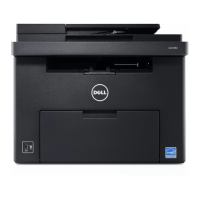
